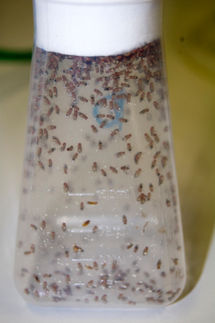How nature tinkers with the cellular clock
Advertisement
The life of a cell is all about growing and dividing at the right time. That is why the cell cycle is one of the most tightly regulated cellular processes. A control system with several layers adjusts when key components of the cell cycle machinery are produced, activated and degraded to make sure that the schedule is kept. These layers of control work differently and are usually studied separately, but researchers at the European molecular biology Laboratory [EMBL] and the Technical University of Denmark [DTU] have now discovered that they change in a highly coordinated fashion during evolution. The study also reveals that although most components of the cell cycle have been conserved over one billion years, the temporal regulation of this process has evolved remarkably fast.
The cell cycle is so fundamental for a cell that its machinery has been almost entirely conserved through evolution. Crucial components are made only at specific times to ensure that each machine is active only during the right phase of the cycle. Comparing cell cycle genes that are conserved between humans, yeasts and thale cress, Peer Bork and colleagues at EMBL and DTU found that while many genes in each organism are expressed only at specific times of the cell cycle, it is not the same genes that are temporally regulated in each species.
"Regulating processes by controlling the time at which genes are expressed is a strategy that is conserved," says Peer Bork, joint coordinator of EMBL's Structural and Computational Biology Unit, "but details of which genes are regulated in this way and the exact timing of their expression have changed a lot throughout evolution. What is really surprising is the speed at which these regulatory systems evolve. We are talking about roughly 100 million years for a big change. On the timescale of evolution this is incredibly fast for such a central process."
To have a safety net when temporal control at the gene level fails, cells also regulate the activity of cell cycle proteins directly, switching them on and off and modifying them at particular sites. A closer look at these proteins revealed that changes in the control of gene expression often go together with changes in the regulation of the corresponding protein.
"To our surprise, we found that these two different mechanisms of temporal control evolve together in a coordinated fashion," says Søren Brunak, Professor at DTU. "This double layer of control seems so important that evolution has conserved it despite dramatic changes in the regulation of each mechanism."
The new insights gained have broad implications. The principles discovered might govern also the control of other temporally regulated systems like embryonic development. The fast evolution of temporal regulation also raises the question in how far general conclusions about regulatory systems can be drawn from studying simple model organisms like yeast or fruit flies.
Original publication: L. J. Jensen, T. S. Jensen, U. de Lichtenberg, S. Brunak, P. Bork; "Co-evolution of transcriptional and posttranslational cell cycle regulation."; Nature 2006.






















































